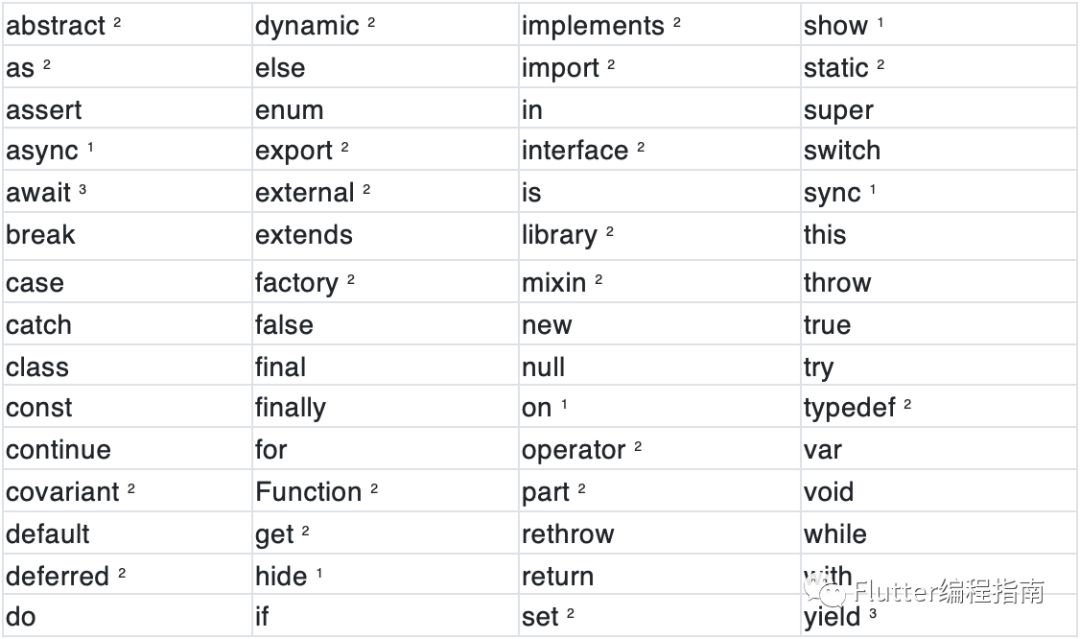前言
Flutter应用程序使用Dart语言开发,Dart是面向对象编程语言,由Google于2011年推出,目前最新版本是2.0,为了更好的使用Flutter进行应用开发,本文将详细介绍Dart语言的语法和特性。
重要概念
在学习Dart之前,先要了解以下Dart相关概念:
- 能够放在变量中的所有内容都是对象,每个对象都是一个类的实例。甚至于数字、函数和null值都是对象,并且所有对象都继承自Object类。
- Dart是强类型语言,但类型标识是可选的,因为Dart可以推断类型。如果要明确说明不需要任何类型,可以使用特殊类型dynamic标识。
- Dart支持泛型,如List或List(任何类型的对象列表)。
- Dart支持顶级函数(例如main函数),以及绑定到类或对象的函数(分别是静态方法和实例方法)。函数内部也可以创建函数(嵌套函数或本地函数)。
- Dart支持顶级变量,以及绑定到类或对象的变量(分别是静态变量和实例变量)。
- 与Java不同,Dart没有关键字public、protected和private。如想设置私有变量或函数,则变量和函数名以下划线(_)开头。
- 标识符可以以字母或下划线(_)开头,后跟这些字符加数字的任意组合。
- Dart有两个表达式(具有运行时值)和语句(不具有)。 例如,条件表达式条件? expr1:expr2的值为expr1或expr2。 将其与if-else语句进行比较,该语句没有任何值。 语句通常包含一个或多个表达式,但表达式不能直接包含语句。
- Dart工具可以报告两种问题:警告和错误。警告只是表明您的代码可能无法正常工作,但它们不会阻止您的程序执行。 错误可以是编译时或运行时。 编译时错误会阻止代码执行; 运行时错误导致代码执行时引发异常。
关键字
任何语言都有关键字,关键字是在编程时不能使用作为标识符的单词。Dart的关键字如下:

编码时应避免使用以上单词作为标识符,如果有必要,可以使用带有上标的单词作为标识符:
- 带有上标1的单词是上下文关键字,仅在特定位置有含义,它们在任何地方都是有效的;
- 带有上标2的单词是内置标识符,它们在大多数地方是有效的,但不能用作为类和类型名称或作为一个导入前缀;
- 带有上标3的单词是与Dart1.0发布后添加的异步支持相关的有限的保留字符,不能在任何标记为async,async * 或sync * 的任何函数体中使用await和yield作为标识符。
变量
变量的定义
1.可以使用var来定义变量,变量的类型可以通过变量值推断出来
var name = "hi"; //String类型var age = 18; //int类型var high = 1.70; //double类型如上变量定义后其类型已经确定,不可再将其他类型的值赋给变量。
var name = "hi"; //String类型name = 3; //此处编译器会报错,name被定义赋值之后已经是一个String类型,不可再赋值int类型值2.也可以使用特定类型来定义变量
String name = "bruce"; //String类型int age = 18; //int类型3.如果变量不限于单个类型,则可以使用dynamic或Object来定义变量
dynamic value = 18;print("value = $value");value = "bruce";print("value = $value");value = 3.5;print("value = $value"); Object val = 18;print("val = $val");val = "bruce";print("val = $val");val = 3.5;print("val = $val");输出结果为
value = 18value = brucevalue = 3.5val = 18val = bruceval = 3.5变量的默认值
由于前文关于Dart的一些概念中说到过,能够放在变量中的所有内容都是对象,所以如果一个变量没有初始化值,那它的默认值就为null。
int value1;print("value1 = $value1");bool value2;print("value2 = $value2");var value3;print("value3 = $value3");dynamic value4;print("value4 = $value4");输出结果为
value1 = nullvalue2 = nullvalue3 = nullvalue4 = nullfinal 和 const
如果不打算更改变量,可以使用final或者const。一个final变量只能被设置一次,而const变量是编译时常量,定义时必须赋值。
// Person类class Person { static const desc = "This is a Person class"; //必须定义时赋值,否则编译时报错 final name; Person(this.name); //对象初始化时赋值一次}// 定义一个Person对象Person p = Person("Bruce"); //创建对象时设置一次nameprint("p.name = ${p.name}"); //可正常输出 p.name = Brucep.name = "haha"; //编译器报错内置类型
Dart语言支持以下类型
- numbers包含int和double两种类型,没有像Java中的float类型,int和double都是num的子类型。
- stringsDart的字符串是一系列UTF-16代码单元。创建方法如下:
String str1 = "hello"; //可以使用单引号或双引号print("str1 = $str1");String str2 = """Hi,BruceThis is Xiaoming."""; //使用带有单引号或双引号的三重引号可以创建多行字符串print("str2 = $str2");输出结果为
str1 = hellostr2 = Hi,Bruce This is Xiaoming.- booleansDart有一个名为bool的类型,只有两个对象具有bool类型:true和false,他们都是编译时常量。
- lists和其他编程语言常见的集合一样,Dart中使用的集合是数组或有序的对象组。Dart中数组是List对象。
List arr = ["Bruce", "Nick", "John"];print("arr = $arr");- maps
Map map = {"name": "Bruce","age": 18,"high": 1.70};print("map = $map");print("map['name'] = ${map['name']}");var map1 = {1: "hi",2: "hello",3: "yep"};print("map1 = $map1");print("map1[1] = ${map1[1]}");输出结果为
map = {name: Bruce, age: 18, high: 1.7}map['name'] = Brucemap1 = {1: hi, 2: hello, 3: yep}map1[1] = hi- runes符文是字符串的UTF-32代码点。在字符串中表示32位Unicode值需要特殊语法,常用方法是 \uXXXX,其中XXXX是4位十六进制值,比如小心心(♥)是\u2665。要指定多于或少于4个十六进制数字,请将值放在大括号中。 比如,微笑()是\u{1f600}。
String smile = '\u{1f600}';print("微笑:$smile");Runes input = new Runes( '\u2665 \u{1f605} \u{1f60e} \u{1f47b} \u{1f596} \u{1f44d}');print(String.fromCharCodes(input));输出结果为
微笑:♥ 函数
Dart是一种真正的面向对象语言,因此即使是函数也是对象并且具有类型Function。这意味着函数可以分配给变量或作为参数传递给其他函数。
定义方法
和绝大多数编程语言一样,Dart函数通常的定义方式为
String getName() { return "Bruce";}如果函数体中只包含一个表达式,则可以使用简写语法
String getName() => "Bruce";可选参数
Dart函数可以设置可选参数,可以使用命名参数也可以使用位置参数。
命名参数,定义格式如 {param1, param2, …}
// 函数定义void showDesc({var name, var age}) { if(name != null) { print("name = $name"); } if(age != null) { print("age = $age"); }}// 函数调用showDesc(name: "Bruce");// 输出结果name = Bruce位置参数,使用 [] 来标记可选参数。
// 函数定义void showDesc(var name, [var age]) { print("name = $name"); if(age != null) { print("age = $age"); }}// 函数调用showDesc("Bruce");// 输出结果name = Bruce默认值
函数的可选参数也可以使用 = 设置默认值
// 函数定义void showDesc(var name, [var age = 18]) { print("name = $name"); if(age != null) { print("age = $age"); }}// 函数调用showDesc("Bruce");// 输出结果name = Bruceage = 18main函数
和其他编程语言一样,Dart中每个应用程序都必须有一个顶级main()函数,该函数作为应用程序的入口点。
函数作为参数
Dart中的函数可以作为另一个函数的参数。
// 函数定义void println(String name) { print("name = $name");}void showDesc(var name, Function log) { log(name);}// 函数调用showDesc("Bruce", println);// 输出结果name = Bruce匿名函数
// 函数定义void showDesc(var name, Function log) { log(name);}// 函数调用,匿名函数作为参数showDesc("Bruce", (name) { print("name = $name"); });// 输出结果name = Bruce嵌套函数
Dart支持嵌套函数,也就是函数中可以定义函数。
// 函数定义void showDesc(var name) { print("That is a nested function!"); //函数中定义函数 void println(var name) { print("name = $name"); } println(name);}// 函数调用showDesc("Bruce");// 输出结果That is a nested function!name = Bruce运算符
Dart中使用到的运算符如下表格
DescriptionOperator一元后缀expr++ expr-- () [] . ?.一元前缀-expr !expr ~expr ++expr --expr乘除操作* / % ~/加减操作+ -移位<< >>按位与&按位异或^按位或|比较关系和类型判断>= > <= < as is is!等判断== !=逻辑与&&逻辑或||是否null??条件语句操作expr1 ? expr2 : expr3级联操作..分配赋值操作= *= /= ~/= %= += -= <<= >>= &=^= |= ??=
下面就对一些对于Java或Objective-C来说未使用过的运算符通过代码来做个介绍。
- ?.的使用
//定义类class Person { var name; Person(this.name);}// 调用Person p;var name = p?.name; //先判断p是否为null,如果是,则name为null;如果否,则返回p.name值print("name = $name");// 输出结果name = null- ~/的使用
// 代码语句var num = 10;var result = num ~/ 3; //得出一个小于等于(num/3)的最大整数print("result = $result");// 输出结果result = 3- as的使用,as用来做类型转化
// 类定义class Banana { var weight; Banana(this.weight);}class Apple { var weight; Apple(this.weight);}// 调用dynamic b = Banana(20);(b as Banana).weight = 20; // 正常执行print("b.weight = ${(b as Banana).weight}");(b as Apple).weight = 30; // 类型转换错误,运行报错print("b.weight = ${(b as Apple).weight}");//输出结果b.weight = 20Uncaught exception:CastError: Instance of 'Banana': type 'Banana' is not a subtype of type 'Apple'- is的使用
// 函数和类代码定义getFruit() => Banana(20); // 获取一个水果对象class Banana { var weight; Banana(this.weight);}class Apple { var color; Apple(this.color);}// 调用var b = getFruit();if(b is Apple) { //判断对象是否为Apple类 print("The fruit is an apple");} else if(b is Banana) { //判断水果是否为Banana类 print("The fruit is a banana");}// 输出结果The fruit is a banana- ??的使用
// 操作代码块String name;String nickName = name ?? "Nick"; //如果name不为null,则nickName值为name的值,否则值为Nickprint("nickName = $nickName"); name = "Bruce";nickName = name ?? "Nick"; //如果name不为null,则nickName值为name的值,否则值为Nickprint("nickName = $nickName"); // 输出结果nickName = NicknickName = Bruce - ..的使用,级联操作允许对同一个对象进行一系列操作。
// 类定义class Banana { var weight; var color; Banana(this.weight, this.color); void showWeight() { print("weight = $weight"); } void showColor() { print("color = $color"); }}// 调用Banana(20, 'yellow') ..showWeight() ..showColor(); // 输出结果weight = 20color = yellow控制流语句
Dart中的控制流语句和其他语言一样,包含以下方式
- if and else
- for循环
- while和do-while循环
- break和continue
- switch-case语句
以上控制流语句和其他编程语言用法一样,switch-case有一个特殊的用法如下,可以使用continue语句和标签来执行指定case语句。
var fruit = 'apple';switch (fruit) { case 'banana': print("this is a banana"); continue anotherFruit; anotherFruit: case 'apple': print("this is an apple"); break;}// 输出结果this is an apple异常
Dart的异常捕获也是使用try-catch语法,不过与java等语言稍有不同
// 定义一个抛出异常的函数void handleOperator() => throw Exception("this operator exception!");// 函数调用try { handleOperator();} on Exception catch(e) { print(e);} finally { // finally语句可选 print("finally");}// 输出结果Exception: this operator exception!finally类
Dart是一种面向对象的语言,具有类和基于mixin的继承。同Java一样,Dart的所有类也都继承自Object。
构造函数
Dart的构造函数同普通函数一样,可以定义无参和有参,命名参数和位置参数,可选参数和给可选参数设置默认值等。Dart的构造函数有以下几个特点:
- 可以定义命名构造函数
- 可以在函数体运行之前初始化实例变量
- 子类不从父类继承构造函数,定义没有构造函数的子类只有无参无名称的构造函数
- 子类定义构造函数时默认继承父类无参构造函数,也可继承指定有参数的构造函数;
命名构造函数和函数体运行前初始化实例变量
// 类定义class Tree { var desc; // 命名构造函数 Tree.init() { desc = "this is a seed"; } // 函数体运行之前初始化实例变量 Tree(var des) : desc = des;}// 构造函数调用Tree t = Tree.init();print("${t.desc}");Tree t1 = Tree("this is a tree");print("${t1.desc}");// 输出结果this is a seedthis is a tree构造函数继承
// 类定义class Fruit { Fruit() { print("this is Fruit constructor with no param"); } Fruit.desc(var desc) { print("$desc in Fruit"); }}class Apple extends Fruit { Apple():super() { print("this is Apple constructor with no param"); } // 默认继承无参构造函数 Apple.desc(var desc) { print('$desc in Apple'); }}// 构造函数调用Apple();Apple.desc("say hello"); // 输出结果this is Fruit constructor with no paramthis is Apple constructor with no paramthis is Fruit constructor with no paramsay hello in Applemixin继承
mixin是一种在多个类层次结构中重用类代码的方法。
// 类定义class LogUtil { void log() { print("this is a log"); }}class Fruit { Fruit() { print("this is Fruit constructor with no param"); }}class Apple extends Fruit with LogUtil { Apple():super() { print("this is Apple constructor with no param"); }}// 调用Apple a = Apple();a.log(); //可执行从LogUtil继承过来的方法// 输出结果this is Fruit constructor with no paramthis is Apple constructor with no paramthis is a log泛型
Dart同Java一样,也支持泛型。
// 类定义class Apple { var desc; Apple(this.desc); void log() { print("${this.desc}"); }}class Banana { var desc; Banana(this.desc); void log() { print("${this.desc}"); }}class FruitFactory<T> { T produceFruit(T t) { return t; }}// 调用FruitFactory<Banana> f = FruitFactory<Banana>();Banana b = f.produceFruit(Banana("a banana"));b.log(); FruitFactory<Apple> f1 = FruitFactory<Apple>();Apple a = f1.produceFruit(Apple("an apple"));a.log(); // 输出结果a bananaan apple 写在最后
本文主要针对Dart不同于其他编程语言的一些语法特性进行了分析和举例,相信读过文本之后大家会对Dart语法有个很系统的了解,后边我们就可以开启Flutter应用开发之旅了。
转自:
https://mp.weixin.qq.com/s/lEUdry-pl40GuHPSYtPYpg
 鲁公网安备37020202000738号
鲁公网安备37020202000738号